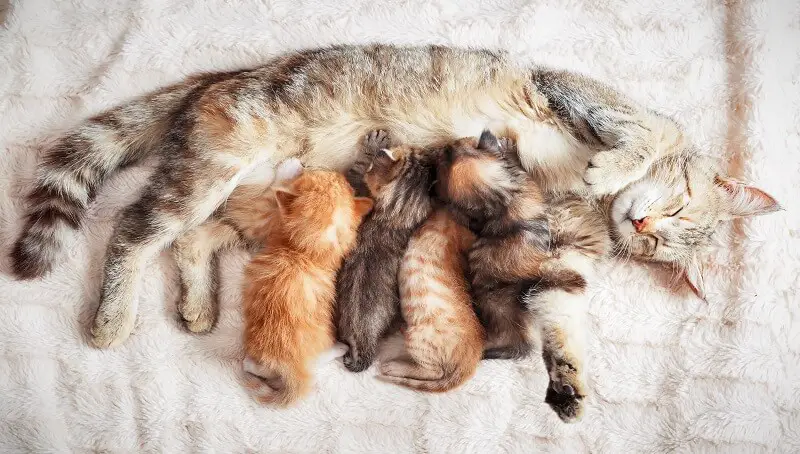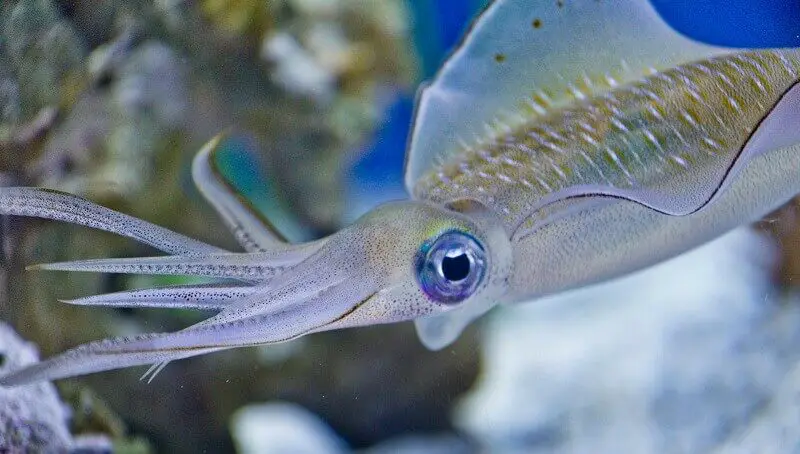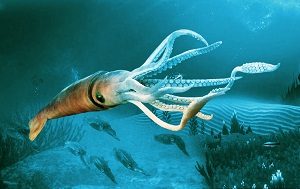
Dogs and Biking; What You Should Consider for A Safe Ride
January 9, 2023
How Long Should a Kitten Stay with Its Mom?
January 10, 2023
The squid is a marine animal that belongs to the order Mollusca, Cephalopoda class. It can be found in all seas. Large populations of squids are located on the coast of Australia.
The squid is a mollusk, and many people classify it as fish, which is wrong.
The common squid, Sepia Officinalis, is the largest and most well-known species of squid. It is native to the Baltic, Nordic, and Mediterranean seas. It lives on the bottom of the ocean with mud and sand at depths of up to 200 meters. There are almost 200 species of squids in the seas and oceans around the world and around 10 species are extinct.
What does the squid eat?
You might also like my articles about whether:
Since they cannot reach high speeds like octopuses, even over short distances, they prefer to hunt using an ambush method. They stay in the dark until the prey reaches them. This creature feeds on shrimp, fish, and crabs.
After it catches the food, it will take it to the mouth and keep it to be eaten or broken with its fleshy beak. This beak is so strong that it can break the larger fish shells and bones.
A 2008 study found that they preferred a particular type of food. After birth, they feed mostly on shrimp and crabs. The presence of prey at a distance of 5 m causes a rapid reflex of orientation toward it and the sudden removal of water from the gill chamber by a powerful jet, which thus pushes the squid toward the prey. The arms catch the prey and the animal suddenly turns with another jet of water now heading to the shelter from which it came out.
An experiment led by a Dutchman shows how squids can distinguish the colors and shapes of objects. On the outside of the aquarium, he put a white paper disc, with a diameter of 10 cm, and immediately at the other corner of the aquarium left a living crab, the perfect food for the sepia. There were two squids in the aquarium.
They saw the disc, then the crab, and quickly headed toward it, they caught it with their arms and one managed to take it to the beak in the middle of the tentacles, to break it and quickly swallow it.
After half an hour the experiment was repeated, then, again and again, the fourth time the white disc was applied to the wall of the aquarium, both species headed toward the corner where they regularly received food. But when the white disk appeared, they would rush at high speed to this place.
Another experiment was made with a vertical red cardboard 20 cm long and 5 cm wide. Its appearance on the wall of the aquarium was accompanied by the throwing of a living crab at the other end of the vessel. After a few repetitions, the sepia headed toward the corner with the crab as soon as the red cardboard was applied to the wall.
How to recognize a squid
Unlike octopuses, squids have a protective cover. They have elongated bodies and 10 tentacles with cupping used to catch prey.
They reach a weight of 5 kg and a length of 60 cm. Many species do not exceed the length of 20-30 cm. The blood is pumped by 3 separate hearts. It is said that the eyes of the squid are the most developed in the animal kingdom.
It is an aquatic animal that moves due to its propulsion capabilities. To move in a certain direction, it gathers water and quickly removes it in the opposite direction.
In the brain housed in a relatively solid cartilage capsule, there are millions of nerve cells, each with well-defined functions. The optic lobes are the largest because their eyes are the most developed of the sense organs.
With the help of vision, the most important reflexes of behavior, attack, or defense are made. Probably also under the impulse of the colors perceived by the eyes, the body coloring is ordered by the brain to be similar to the external one.
The eyes are located on both sides of the head and they are very similar to those of mammals and humans, as they are yellowish and very expressive. The iris is pigmented, and the size of the pupil is regulated by the amount of light in the environment. The brighter it is, the smaller the iris.
They have a great deal of tactile sensitivity. In the dark, they distinguish between many shapes, like the shape of a crab hidden between the stones that they catch with their arms and take to the shelter, where they always rotate it in their arms.
Behavioral traits
 Because of its ability to change color to camouflage, it is called the “chameleon of the sea”. It changes its color very easily depending on where it is placed: between algae, on the sand, etc.
Because of its ability to change color to camouflage, it is called the “chameleon of the sea”. It changes its color very easily depending on where it is placed: between algae, on the sand, etc.
When attacked, it throws a black substance from an “ink gland” that reduces visibility in the water. With this trick, it can easily get away from predators. The natural predators of the squid are dolphins, swordfish, shark whales, and other larger squids or fish.
The movements of the arms are very complex and can be compared to the movements of the human fingers. Each arm has to perform a certain task. Some catch stones and lead them to the construction of the shelter, and others grab prey that has passed nearby.
Recent studies confirm that the squid is the smartest invertebrate.
They sleep both during the day and at night. During this time, they remain still, their color opens up, and the number of breaths drops from 30 to 12 per minute.
Most commonly known for
Squid is a tasty food that can be prepared in the oven, barbecued, fried, marinated, or filled.
They left an important mark on the culture of mankind because people used to write with sepia ink. Apart from the ink used to make paints, sepia has a bone called the “sepia bone” which is very rich in calcium.
The bone of the squids was also used for grinding metal or tooth shining.
Japanese researchers have found that squid fat has antibiotic properties.
Sepia is also known as the only organic representative of brown paints.
Reproduction of Sepia
The primary condition for the survival of a squid is the temperature, and depending on this it can live 1.5 years, 2 or more.
People who want to keep squids in aquariums and reproduce them should really know what they are doing. Choose their gender carefully because if you put two males in the same place, they will fight. There is a high chance that a female and a male will fight too because they do not have optimal conditions, but two same-sex squids will certainly fight.
After mating, the female will lay one egg at a time. The eggs will start hatching after about 50 days, depending on the temperature.
It is assumed that the male grasps the female with tentacles and turns it so that it reaches face to face. Then it pushes a tentacle into an opening near the female’s mouth.
Facts and how a squid hunts!
They can change the color and texture of their skin in a fraction of a second. Simply! The whole body! The whole body can turn from red to green. They have different types of sacks. They are called pigmented sacks and are surrounded by muscles. When the muscles contract, they tighten the bag so that it releases a certain color. And so, their whole body is covered in it. They are called chromatophores, having these pigment-containing cells, which can make them have different colors.
They have different types of color mechanisms. Some are called aritaphors and they reflect light. They use the same types of light reflection that probably occur on the butterfly’s wings when they reflect light and you can see its colors.
The other types are called lucaphors, and they are white in color. They have small white dots on them, so for each independent color, they mix different mechanisms to result in the color they want.
They have feelings, and they can get angry. When they get angry, they become red. The whole body turns red. Suddenly! If they get scared, they can become yellow or green, or they can go down to the bottom of the ocean and take the color of the sand.
They may also have small bumps that appear on their skin and can mimic rocks. Sometimes they will imitate the brown algae with the help of the eight tentacles in front. They will change their shape and turn green and will float with the algae. They have, what is called, neutral buoyancy.
These small animals can pump air or water into the bones. If they want to float in water, they can take a certain amount of water out of their bones or insert a certain amount of air into their bones so they can float. They can insert a jet of water into the bones and then quickly go down.
They think! They really think and see very well. In fact, they have a “W” shaped pupil. It almost looks like Batman when you see a picture of the pupil’s shape. The squid has binocular vision. These strange creatures can focus on one thing with their eyes. Both their eyes can look at the same place, as we humans do; thus, they locate their prey. They go up and down to mislead the prey before eating it.
Some of them have the ability to light a kind of light on their head. These lights give you the impression of old cinema halls with lights all around. They walk with these lights on and use them to turn to what they want to eat.
They then turn on all their mechanisms and start playing with the lights. It has two skin extensions on the two sides of the head. Hidden under these extensions, there are two long tentacles, but they are different. These are the tentacles they feed on. The squids take them out and catch their prey. They quickly pull them out and then pull them back. With these tentacles, they catch food, and in this way they feed.
They think, see, and draw conclusions about certain things. They know how to hunt their prey. They know when it’s time to turn on their lights or remove their tentacles to catch food, so they make certain decisions.
